Cross-posted from my dad blog…
Back in November, I recommended some family board games for those interested in options other than classics like Candy Land and Monopoly. As you might have guessed, I picked up a few new board games for the family over Christmas, and I thought I would share some reviews here on the blog. If you’re looking for new games to add to your family game night rotation, read on…
Ghost Blitz (Zoch Verlag) – I kept hearing about this German game on the Snakes & Lattes podcast. It sounded just like the kind of silly fun that my girls would enjoy, and I was right. The game comes with five small objects: a white ghost, a grey mouse, a blue book, a green bottle, and a red chair. Also included is a stack of cards, each showing two of these objects, usually miscolored. To play, you turn over the card on the top of the stack, then grab the object not represented on card. For instance, if the card shows a green ghost and blue mouse, then you should grab the red chair because neither the shape (chair) or color (red) is on the card. However, sometimes one of the five objects is shown correctly on the card, in which case that’s the one to grab.
This is a game of speed and visual recognition, and it’s just hard enough to be interesting. The 7-year-old is a big fan of the game Pictureka, which also involves spotting things on the table in front of you, and she’s really good at it, usually beating me when play. She took to Ghost Blitz right away, although she finds it more challenging than Pictureka. I sometimes have to throw the game to keep her from getting frustrated, but it’s an easy game to throw.
The game goes quickly, maybe 15 or 20 minutes to go through the entire stack of cards and determine a winner. The box says you can play it with as many as 8 players. I would imagine having eight adults around the table grabbing at ghosts and bottles and books would get pretty intense! You can find the game at Amazon or Funagain Games online.
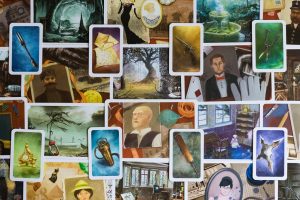
Mysterium (Portal Games) – This game was apparently all the buzz at BGG.Con, the BoardGameGeek convention, last year. I didn’t go, but I followed the Twitter backchannel, and Mysterium sounded interesting enough to pay the extra shipping to order it from Poland. That’s right, it’s a Polish game, actually titled Tajemnicze Domostwo (“Mysterious Homestead” according to Google Translate), not yet available in English. Language isn’t a problem, however, since the game has no words!
Mysterium is a visual version of the classic board game Clue. Like Clue, the goal is to identify a murderer, and you have to figure out who committed the crime, where in this spooky old mansion the murder took place, and what weapon was used in the crime. Unlike Clue, Mysterium is a cooperative game, with all the players working together to solve the mystery. A number of possible culprits, locations, and weapons are drawn from their respective card decks and placed face up on the table. One player takes the role of a ghost, who knows the true culprit. The other players are psychic investigators.
 Each investigator is secretly assigned a who-where-what set by the ghost, who then sends dreams — in the form of surreal and sometimes creepy paintings, drawn from a deck of “dream cards” — to the investigators to point them to their respective culprits, locations, and weapons. Once all the investigators have identified their individual sets, the ghost selects one of the sets as the actual murderer, location, and weapon, then uses more dream cards to guide the players to that final set. All of this is done with a ticking clock — you only have seven rounds of guessing to catch the true culprit!
Each investigator is secretly assigned a who-where-what set by the ghost, who then sends dreams — in the form of surreal and sometimes creepy paintings, drawn from a deck of “dream cards” — to the investigators to point them to their respective culprits, locations, and weapons. Once all the investigators have identified their individual sets, the ghost selects one of the sets as the actual murderer, location, and weapon, then uses more dream cards to guide the players to that final set. All of this is done with a ticking clock — you only have seven rounds of guessing to catch the true culprit!
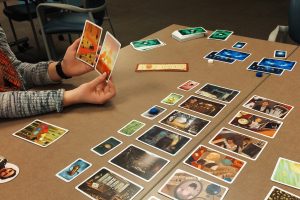
The girls and I love this game, especially the seven-year-old. There’s no real strategy involved, just a lot of visual interpretation. The dream card showing a music box showing a dancing ballerina, is that supposed to hint at the conductor or the watchmaker? The evening scene of the teddy bear lying next to a wrought-iron gate, could that indicate the child’s bedroom or should the green hue of the scene point me to the garden? The girls and I can play on equal footing, any of us can take on the role of the ghost, and the game works well for two or three players. It’s also great with adults — we had so much fun playing it at my last game night that we had to play it twice! Each game takes maybe 20 or 30 minutes, depending on the number of players, and you can play with up to 7 players, including the ghost.
Getting a copy is a little challenging. I ordered mine directly from Portal Games in Poland, but their online shop seems to be sold out at the moment. Until the US edition comes out later this year, your best bet is to check the BoardGameGeek forums for leads. And if you do manage to get a copy, you’ll want to read through the English translation of the rulebook and use “Full Mystery” alternate endgame rules. (The final round is played differently in the original Polish version, but the “Full Mystery” version is more fun.)
Mice & Mystics (Plaid Hat Games) – I learned about this cooperative game after playing Dead of Winter (see below) by the same publisher. In Mice & Mystics, players get to be heroes trapped in the form of very adorable mice. There’s a prince, a blacksmith, a magician, a healer, and a thief, all magically turned into mice, scurrying around a castle trying to defeat the evil sorceress who has entranced the king. Villains include rats, cockroaches, and a cat, among others.
The game comes with a storybook, with each chapter including some narrative and a scenario to play through. Think of the game as a role-playing game you play on your kitchen table instead of your XBox. All the action takes place by moving miniatures (again, adorable mice) around a set of tiles, with lots of dice rolling to handle combat and other challenges. Your warrior mice can get wounded or captured, pick up special equipment, or learn new skills. The “currency” of the game is cheese — you earn wedges of cheese for various heroic feats and spend cheese to use special abilities or learn new ones.
As I’ve mentioned here before, my competitive seven-year-old doesn’t always handle losing well, so we play a lot of cooperative games in my house. Mice & Mystics is one of the more complex cooperative games we’ve played, but halfway through the first chapter we got the hang of it. As a cooperative game, it’s up to the players to make sure all the rules are followed, and I sometimes wish I had a second adult at the table to help with that. But we’re managing, and, frankly, I don’t really care if we bend the rules here and there as long as we’re having fun.
The seven-year-old wanted to play the mouse archer Lily (imagine that!), who isn’t introduced until the second chapter, so she just watched the first time we played. That helped her get ready to actually play the second chapter. Unfortunately, Lily (the mouse) spends the entire second chapter trapped in a cage (with the other mice trying to free her), so Lily (the girl) didn’t have much to do other than shoot arrows at approaching cockroaches. Chapter three, in which Lily (the mouse) is a full member of the party, should be more engaging.
The box says that the game is for ages seven and up, and that’s about right, assuming your seven-year-old has a relatively long attention span. But younger players (or older players with shorter attention spans) can still participate since it’s a cooperative game. The adults in the room might need to help more, letting the younger players have fun rolling dice and moving the figures (once more, adorable) around the board.
You can play Mice & Mystics all by yourself if you like, or with as many as four players. The box says each chapter takes between 60 and 90 minutes, but we’ve found that they take much longer than that, maybe two or three hours. The chapters might get faster as we get more experienced, but I doubt that, since I think the chapters also get harder. It’s not a cheap game. The starter set retails for $75, but it comes with 11 chapters to play through, so there’s plenty of play time you get for your money. And when you finish those 11 chapters, you can purchase expansions for more story and more warrior mouse fun. You can buy the game from Funagain Games or Plaid Hat Games (the publisher), but it’s usually a lot cheaper on Amazon.
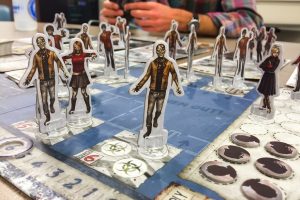
Dead of Winter (Plaid Hat Games) – Dead of Winter is my new favorite game. It might be my favorite game of all time. It’s strategic, thematic, challenging, stressful, and a little bit freaky. It’s a semi-cooperative game where players work together (for the most part) to survive a wintry zombie apocalypse. It’s a bit like an episode of The Walking Dead as a board game. Each player controls a number of “survivors,” colorful characters each with strengths, weaknesses, and special abilities. There’s Sophie Robinson the pilot, Gabriel Diaz the fireman, Brandon Kane the janitor, Daniel Smith the sheriff, and even Sparky the stunt dog. Your survivors must search for supplies (food, medicine, weapons, and so on) around town (at the police station, the library, the school, etc.) while fending off zombie attacks and risking frostbite. Each round presents a new crisis, perhaps a food shortage or flu outbreak or zombie surge, that requires the players donate certain kinds of supplies or face disaster.
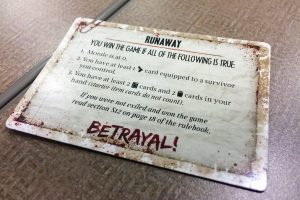 To win the game, you have to complete the main objective, which can vary from game to game and something all the players work on together, along with your personal secret objective. It’s possible to complete the main objective without completing a secret objective, so sometimes everyone wins, sometimes only some players win. What really propels the game, however, is that one of the players might be a traitor, with a secret objective that requires that the main objective is failed! And there are lots of ways a traitor can sabotage the team, from withholding food, providing the wrong kind of supplies for the crisis at hand, or even sending his own survivors out into harm’s way.
To win the game, you have to complete the main objective, which can vary from game to game and something all the players work on together, along with your personal secret objective. It’s possible to complete the main objective without completing a secret objective, so sometimes everyone wins, sometimes only some players win. What really propels the game, however, is that one of the players might be a traitor, with a secret objective that requires that the main objective is failed! And there are lots of ways a traitor can sabotage the team, from withholding food, providing the wrong kind of supplies for the crisis at hand, or even sending his own survivors out into harm’s way.
That’s why I called the game “semi-cooperative.” You might have a traitor working against you, and even if you don’t, everyone has a secret objective that can work against the team. For instance, in one game my secret objective was “Hoarder.” To win, I needed more cards in hand at the end of the game than any other player. That made it hard for me to contribute food to the colony or supplies to the various crises we faced!
There’s a capricious element to the game that makes it challenging and sometimes frustrating, but really helps sell the zombie apocalypse theme. For instance, every time you kill a zombie or even move from one location to another, you roll the “exposure die.” Half the time, nothing happens, but sometimes your survivor gets a wound (three wounds and your survivor is dead), sometimes she gets frostbite (a wound that generates more wounds over time), and sometimes your survivor gets bitten and dies instantly! Seriously, this game has a 1 in 12 chance of instant death by zombie. There are ways to avoid rolling the exposure die (using a gasoline card while traveling, or a gun while fighting zombies), but the game can be brutal. Don’t get attached to your survivors!
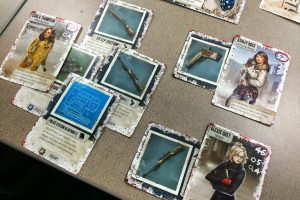
I learned about Dead of Winter from the Quarter to Three podcast, which is run by the brother of one of my work colleagues. The podcast episode features an interview with the game designers, and after listening to the interview, I just had to get the game. I ordered it shortly before Christmas, and I’ve played it five times since then, each with a different group of newbies. First time: I was the traitor, but I didn’t sabotage fast enough and the other players won. Second time: My friend Eric was the traitor, and I did not see that coming. Everyone lost, including Eric. Third time: I was the traitor, and this time I was successful. Sorry, guys. Fourth time: No traitor, and everyone won, but not without some tough sacrifices along the way. My brother’s secret objective required him to have an item equipped to each of his survivors. He didn’t have an item for Bev Russell the mother on the final round, so he sent her to the police station, which was overrun by zombies. Sorry Bev!
My fifth play was with the eleven-year-old. She was hesitant to play Dead of Winter at first, given the creepy zombie theme. But after seeing the Watch It Played family go through a game, she wanted to try it. The chance of playing Sparky the stunt dog helped, too! Dead of Winter provides a two-player, fully cooperative version, with no secret objectives or traitors. The coop version doesn’t have the same edge as the regular version, but it’s still fun and challenging. I suspect we’ll play it again sometime, although probably not as often as Mice & Mystics. The game is rated for ages 13 and up, but the eleven-year-old had no problem playing the coop version. I think the full version might be too challenging for her, given the traitor mechanics.
You can play Dead of Winter with 2 to 5 players. The box says each game takes 1-2 hours, but I would plan at least 3 hours for your first game. It’s a complicated game, and learning to play takes some time. But, as with most games, once you get to the second or third round, you get the hang of it. I suspect that with experienced players and some of the shorter main objectives, you could play in an hour or so. But the game encourages storytelling, so better to plan on a longer game. You can buy the game from the publisher Plaid Hat Games or online retailers Funagain Games or Amazon. It’s available as a write this, but Dead of Winter sells out quickly. There are often weeks between new shipments, so act fast.
